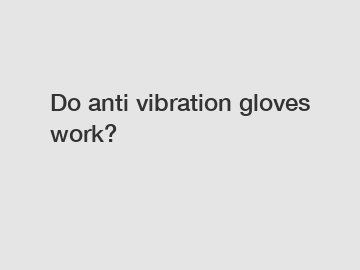Do anti vibration gloves work?
Do anti-vibration gloves work? It's a question commonly asked by individuals exposed to high levels of vibration in workplaces such as construction sites, manufacturing facilities, and even in recreational activities like motorcycling. These gloves are specifically designed to reduce the harmful effects of vibration transmitted through hand-arm systems. While they may seem like an ideal solution, it is essential to analyze their effectiveness and consider other factors that can contribute to hand-arm vibration syndrome (HAVS) prevention.
1. Understanding HAVS:
Hand-arm vibration syndrome is a condition caused by prolonged exposure to vibrating tools or equipment. It commonly affects individuals who regularly use jackhammers, chainsaws, drills, and grinders. HAVS can result in symptoms such as numbness, tingling, pain, and reduced grip strength. To prevent or mitigate HAVS, anti-vibration gloves have been introduced as a potential solution.

2. How do anti-vibration gloves work?
Anti-vibration gloves are constructed using different materials and technologies to absorb and dampen the vibrations transmitted to the hands during tool operation. These gloves typically incorporate materials such as gel padding, air bladder systems, or vibration-damping materials like foam or neoprene. The idea is to create a barrier between the hand and the vibrating tool, reducing the impact on the hand-arm system.
3. Evidence supporting the effectiveness of anti-vibration gloves:
Several studies have examined the effectiveness of anti-vibration gloves in reducing vibration exposure and preventing HAVS. While some research suggests that these gloves provide a certain level of protection, the results are inconclusive. Factors such as glove fit, duration of use, and specific tool characteristics can significantly influence their effectiveness. It is important to note that anti-vibration gloves should be used as part of a comprehensive approach to HAVS prevention, which includes engineering controls, work practices, and regular breaks.
4. The importance of proper glove selection and fit:
One crucial aspect often overlooked is the selection of appropriate anti-vibration gloves for the task at hand. Different tools produce varying levels of vibration, and gloves should be chosen accordingly. A glove that works well for high-frequency vibrations may not provide the same level of protection for low-frequency vibrations. Moreover, a proper fit is crucial for optimal performance. Ill-fitting gloves can restrict hand movement, leading to increased fatigue and discomfort.
5. Limitations of anti-vibration gloves:
It is important to understand that while anti-vibration gloves can help reduce vibration exposure, they cannot eliminate it entirely. No glove can fully eliminate the vibration transmitted through the tool to the hand. Additionally, gloves may not be effective in scenarios where the vibration source is transmitted through the body, such as when using vibrating seat platforms or machinery.
6. Supplementary measures for HAVS prevention:
Using anti-vibration gloves alone is not enough to prevent HAVS. It is essential to implement a comprehensive strategy that includes regular tool maintenance, equipment replacement, appropriate tool selection, job rotation, adequate rest periods, and employee training on vibration hazards. Employers should also consider implementing administrative controls, such as limiting exposure time and monitoring vibration levels, to ensure worker safety.
7. The role of technological advancements:
With advancements in technology, newer solutions are being developed to address the issue of hand-arm vibration. Some examples include vibration-damping coatings applied to tool handles or anti-vibration mounts on equipment. These innovations aim to reduce vibration at its source, rather than relying solely on personal protective equipment like gloves.
In conclusion, while anti-vibration gloves can provide some degree of protection against HAVS, their effectiveness varies depending on factors such as glove selection, fit, and the specific tools being used. To effectively prevent HAVS, a multi-faceted approach including the use of appropriate gloves, engineering controls, work practices, and regular breaks is crucial. Anti-vibration gloves should be seen as one component of a comprehensive strategy for ensuring worker safety in high vibration environments.
If you are looking for more details, kindly visit haoze, What is SBR latex used for?, Styrene-Butadiene Rubber vs Styrene-Butadiene Latex.
198
0
0

Comments
All Comments (0)